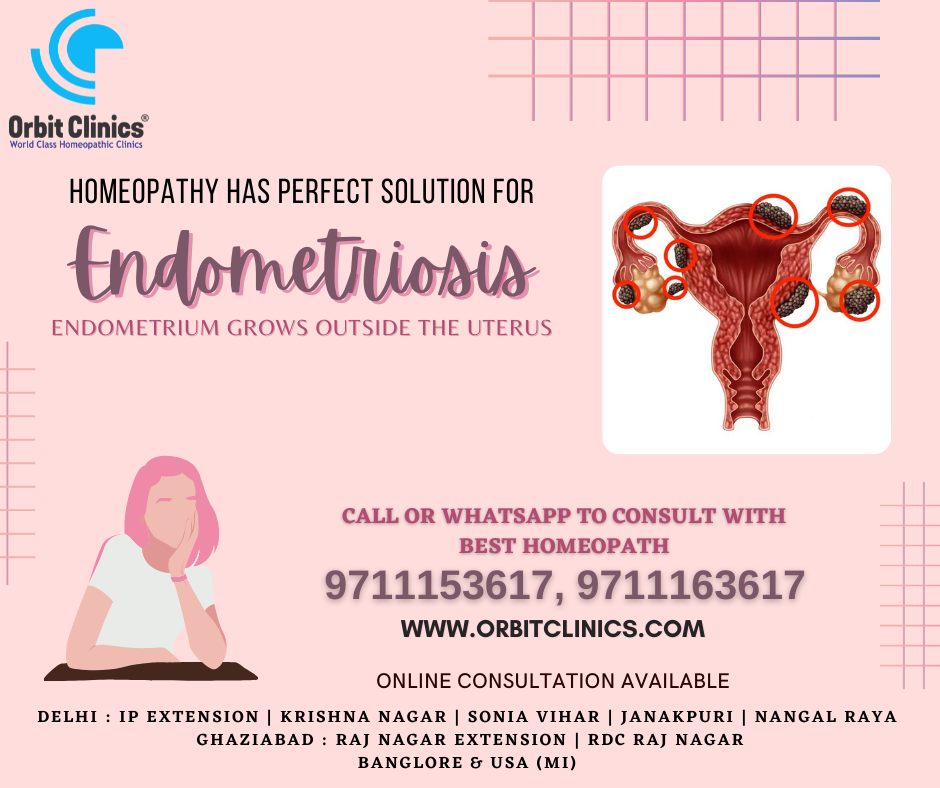ENDOMETRIOSIS / ENDOMETRIOMA AND HOMEOPATHY

Written by
Dr. Deepak Sharma
BHMS, MD, Ph.D. (Scholar)
Homeopathic Physician and Educator
Founder – Orbit Clinics
| Features | Endometriosis | Endometrioma |
| Definition | The tissue lining the inside of the uterus grows outside the uterus, causing pain and discomfort. | A cyst that forms when endometrial tissue grows within the ovary, causing severe pain and complications. |
| Location | Endometrial tissue can grow on the ovaries, fallopian tubes, bowel, bladder, and other areas in the pelvic cavity. | Endometriomas are found exclusively in the ovaries. |
| Symptoms | Painful periods, pelvic pain, painful intercourse, infertility, and bowel and bladder symptoms. | Pelvic pain, painful intercourse, and infertility. |
| Diagnosis | Medical history, physical examination, imaging tests, and laparoscopy. | Medical history, physical examination, imaging tests, and ultrasound. |
| Risk Factors | Family history of endometriosis, early onset of menstruation, short menstrual cycles, and low body mass index (BMI). | Family history of endometrioma, infertility, and prior surgery for ovarian cysts. |
| Complications | Infertility, adhesions, bowel and bladder problems, and ovarian cysts. | Infertility, ovarian torsion, and rupture of the cyst, which can cause severe pain and internal bleeding. |
| Prognosis | There is no cure for endometriosis, but treatment can help manage symptoms and improve fertility. | The prognosis for endometrioma is generally good, but recurrence is possible after treatment. Fertility outcomes depend on the extent of the cyst and the success of treatment. |
Diet:
- Anti-inflammatory foods: Eating a diet that is rich in anti-inflammatory foods can help reduce inflammation and ease pain associated with endometriosis. Examples of anti-inflammatory foods include fatty fish, nuts, seeds, berries, leafy greens, and turmeric.
- Avoid inflammatory foods: It is also important to avoid foods that may trigger inflammation, such as processed foods, red meat, dairy, gluten, and refined sugar.
- Fiber-rich foods: Consuming a diet that is high in fiber can help reduce estrogen levels in the body, which can improve endometriosis symptoms. Examples of fiber-rich foods include fruits, vegetables, whole grains, and legumes.
- Omega-3 fatty acids: Incorporating omega-3 fatty acids into your diet can also help reduce inflammation and pain. Foods rich in omega-3s include fatty fish, flaxseeds, chia seeds, and walnuts.
Exercises:
- Low-impact exercises: Low-impact exercises such as yoga, Pilates, walking, and swimming can help manage endometriosis symptoms by reducing stress, improving circulation, and easing pain.
- Stretching: Incorporating stretching exercises into your routine can also help relieve endometriosis pain and improve flexibility.
- Pelvic floor exercises: Strengthening the muscles of the pelvic floor can help improve bladder and bowel function, reduce pain during intercourse, and improve overall pelvic health.
- Aerobic exercise: Aerobic exercise such as cycling or running may be helpful in managing endometriosis symptoms, but it is important to listen to your body and avoid high-impact activities that may exacerbate pain.
Homeopathy:
Here are a few common homeopathic remedies for endometriosis and endometrioma
- Belladonna: For intense, sudden onset of pain with a feeling of heat and redness.
- Sepia: For pain during intercourse, heavy bleeding, and a dragging or bearing down sensation.
- Lachesis: For pain in the left ovary and a feeling of constriction around the waist.
- Calcarea carbonica: For pain that is worse before menstruation and heavy, prolonged periods.
- Nux vomica: For painful periods with constipation and digestive issues.
- Bryonia: For pain that is worse with movement or pressure and better with rest.
- Pulsatilla: For pain that is relieved by gentle movement and a feeling of weepiness.
- Ignatia: For pain with emotional stress or grief.
- Natrum muriaticum: For painful periods with a headache and a feeling of sadness or isolation.
- Aurum metallicum: For pain with depression and feelings of worthlessness.
- Phosphorus: For heavy periods with bright red blood and a feeling of weakness.
- Kali carbonicum: For pain that is better with warmth and worse at night.
- Conium: For pain in the left ovary with a feeling of coldness and weakness.
- Staphysagria: For pain during intercourse and a feeling of shame or guilt.
- Sabina: For pain with heavy bleeding and a tendency to bruise easily.
- Thuja: For pain with a history of sexually transmitted infections.
- Hamamelis: For heavy, painful periods with dark, clotted blood.
- Arsenicum album: For burning pain with anxiety and restlessness.
- Iodum: For pain with weight loss and hyperthyroidism.
- Kali iodatum: For pain with a history of thyroid issues and sinusitis.
It is important to note that homeopathic remedies should be selected and prescribed by a qualified homeopath after a thorough consultation and evaluation of the individual’s symptoms and overall health.
In summary, endometriosis and endometrioma are two related but distinct conditions that can cause pain, discomfort, and complications in women. Endometriosis refers to the growth of endometrial tissue outside the uterus, while endometrioma is a type of cyst that forms within the ovary. Both conditions can be diagnosed through a combination of medical history, physical examination, imaging tests, and surgical procedures, and can be treated with medications, hormonal therapy, and surgery. However, they differ in terms of location, symptoms, risk factors, and complications, and may require different approaches to management and treatment.




